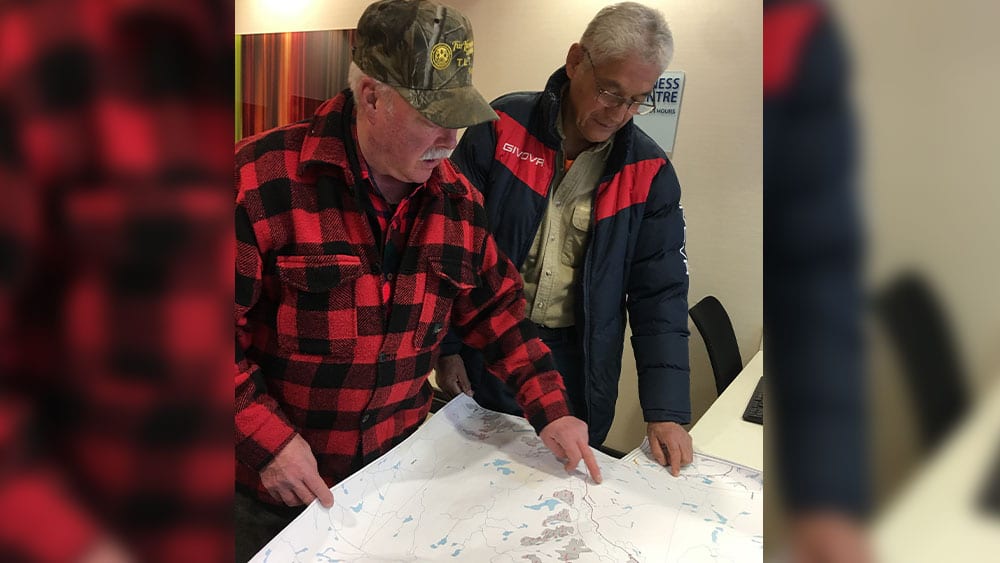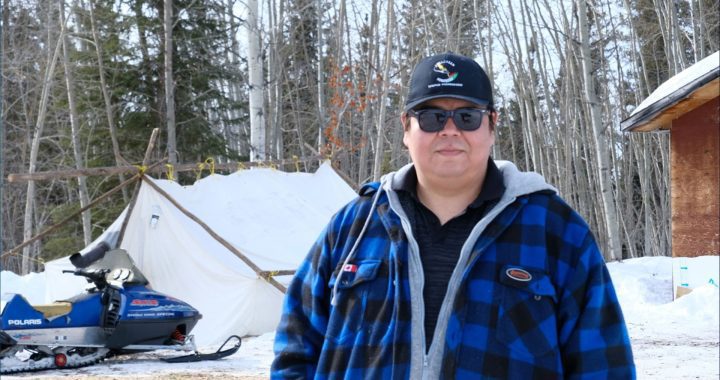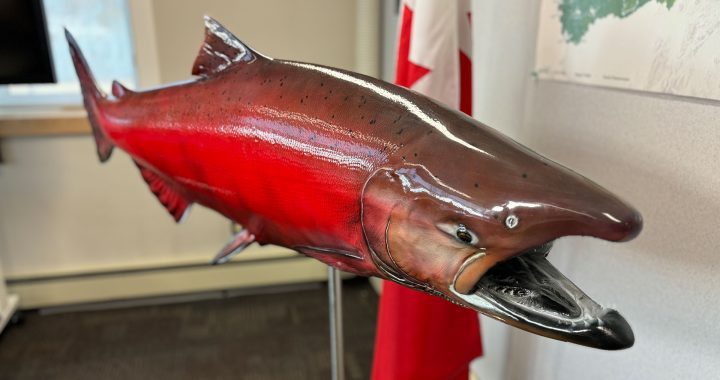While a trial in San Francisco makes headlines around the world, a group of trappers and Indigenous Elders in Ontario are taking note.
San Francisco has become a hot spot for legal challenges against Monsanto, the subsidiary of Bayer which produces much of the world’s glyphosate-based herbicide, commonly known by the trademark Roundup.
A jury trial in San Francisco agreed on March 19, that California man Edwin Hardeman’s lawyers had proven that exposure to the Monsanto product Roundup was a substantial factor in causing his non-Hodgkin lymphoma.
(The United States District Court for the Northern District of California where Edwin Hardeman’s suit against Monsanto is being tried. Photo: Josh Grummett/APTN Investigates)
The second phase of the Hardeman trial is now focused on liability and damages.
Meanwhile in the Robinson Huron Treaty area of Ontario, a group calling itself the Traditional Ecological Knowledge [or TEK] Elders have gotten nowhere in their efforts to stop the aerial spraying of glyphosate-based herbicide as a forest management practice.
“The Anishinaabeg do not believe in any chemical use in their territory,” said TEK co-founder Ray Owl. “If it can kill one item, one blade of grass, it’s not good.”
In the forestry industry, it has become common to use glyphosate-based herbicide to kill off plants that will compete with newly planted seedlings in areas that have been clear cut.
But the TEK Elders and some trappers in the Robinson Huron Treaty area say they are seeing declines in animal numbers which they attribute to glyphosate herbicide.
Owl and his TEK group have approached both the federal and provincial governments about their concerns in regard to the aerial spraying of glyphosate-based herbicide in Robinson-Huron Treaty territory.
(Trappers Bob Behrens and Joe Jones study a map of the area around Behrens’ trap line near Sault Ste. Marie, Ont. Photo: Christopher Read/APTN Investigates)
“They’re really good at playing ping pong,” said Garden River First Nation Councilor Sue Chiblow of the government response to the TEK inquiries.
Chiblow helps organize the TEK Elders’ efforts to stop the aerial spraying of glyphosate herbicide.
“We went to the Ministry of Natural Resources and they said ‘well no we just issued the license so that’s not our problem, it’s Health Canada’s problem” said Chiblow. “So we went to Health Canada and they said ‘well we don’t actually do the spraying, we’re just saying that it’s ok and it’s up to the companies to use it or not use it.”
Bob Behrens is a trapper from Sault Ste. Marie who has also written to the provincial government with his concerns.
Behrens has been trapping on the same trap line since 1985 and says he has been watching animal numbers dwindle since 1988 when he was informed in a letter from the MNRF that Vision – a glyphosate-based herbicide made by Monsanto for forestry applications – was to be sprayed where he traps.
“We had an abundance of rabbits, songbirds, porcupines, beaver. They all started to decline – rabbits just started to reappear last year. And I’m going to say for a 20-year period there were no rabbits here. A lot of the trappers are having problems with the decline in beaver,” said Behrens.
Behrens’ friend and fellow-trapper Joe Jones of Garden River First Nation has seen dwindling numbers of animals too.
This most recent trapping season, Jones – who is also one of the TEK Elders – began noticing a change in beaver meat he’s harvested – and he wonders if its connected to the spraying.
“Eating the beaver, this fall it’s going black,” said Jones, “Especially the bigger beaver. You cut ‘em open . . . it’s not as red, it’s really black.”
(Trapper Bob Behrens demonstrating how to set a trap on his trap line near Sault Ste. Marie. Photo: Christopher Read/APTN Investigates)
In 2017, Behrens asked the federal Ministry of the Environment and Climate Change to conduct a review of the use of glyphosate herbicide in forestry, but he was told by the department that a review was “not warranted.”
APTN Investigates requested interviews with the Ministry of Natural Resources and Forestry but those requests were declined.
The ministry did email APTN a statement, which said in part, “Herbicide use is very limited in Ontario and they are only used when absolutely necessary – usually amounts to less than 0.2 per cent of Ontario’s forested area in any given year….Health Canada recently re-evaluated the use of glyphosate, finding no unacceptable risks to human health or the environment when used as directed.”
However, a federal government publication about forestry acknowledges that glyphosate based herbicide causes reductions in animal numbers.
“Short-term reductions in numbers of some wildlife species (e.g., small animals or birds) are known to occur,” the publication Frontline put out by the Canadian Forestry Service in Sault Ste. Marie states.
The article goes on to say that, “Such changes are typically quite transient, with numbers returning to normal levels within 2-3 years as vegetation and preferred habitat or food re-establishes on the treated site.”
The Frontline publication also notes that similarly moose and deer may also avoid glyphosate-treated areas for “a few years.”
However, Jones and Behrens say they have noticed ongoing declines in animal numbers over a 30 year period.
Some reports indicate glyphosate may disrupt the endocrine systems of animals and humans. Endocrine disruption could result in changes to metabolism, growth and development, tissue function, sexual function etc.
But most of the governmental regulatory agencies in the world say that glyphosate ought to be safe – in contrast to decisions made by two juries in recent San Francisco court cases.
Most recently, a jury ruled this week that Edwin Hardeman’s lawyers had proved “by a preponderance of evidence that his exposure to Roundup was a substantial factor in causing” his non-Hodgkin lymphoma.
Previous to the Hardeman case, a San Francisco-area man named Lee Johnson was awarded U.S. $289 million by a jury in 2018. The judge later slashed Johnson’s amount to US $78 million – and Johnson has yet to see a penny of it due to appeals by the Monsanto legal team.
In determining punitive damages, the jury in the Johnson trial determined that Monsanto had acted with “malice and oppression” in attempting to conceal their product’s potential danger.
Bayer, the parent company which now owns Monsanto, maintains that glyphosate herbicide is a safe product and in a recent statement they point to “more than 800 rigorous studies” submitted to the U.S. Environmental Protection Agency and other regulators, as well as the “largest and most recent epidemiologic study” which followed more than 50,000 pesticide applicators for more than 20 years and found no association between glyphosate-based herbicides and cancer.
But the fact that Johnson’s lawyers were able to convince the jury that his non-Hodgkin lymphoma was caused by his exposure to glyphosate has emboldened a wave of litigants, and more than 11,000 people have filed similar suits against Monsanto in the U.S.
(Trapper and TEK Elder Joe Jones with Garden River First Nation councillor Sue Chiblow. Photo: Christopher Read/APTN Investigates)
The question of whether this legal trend will continue to gather momentum is on the minds of the TEK Elders, as is the question of what effect it may have on regulators such as Health Canada.
The World Health Organization’s International Agency for Research on Cancer classified glyphosate as a “probably carcinogenic to humans” in 2015 – and for that reason, the TEK elders have decided to write to the WHO for help in their fight to shut down aerial spraying in their territory.
Chiblow is optimistic about the letter to the WHO she’s beginning to write.
“They dictate to other governments about health and what’s good and what’s bad,” said Chiblow. “So the World Health Organization should be able to assist.”
Jennifer Moore is one of Edwin Hardeman’s two main attorneys, and she also thinks contacting the WHO is a smart move.
“Going to the Wold Health Organization is absolutely the right thing they should do,” said Moore.
“They need to get away from any type of body that is subject to political pressure because what we have seen is that Monsanto has incredible lobbying efforts.”














